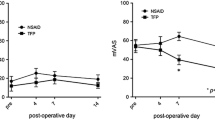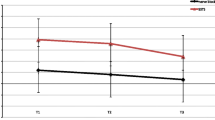Abstract
Background
This randomized controlled trial compared a standard patient controlled analgesic (PCA) regime with a transdermal and oral Fentanyl regime for post-operative pain management in patients undergoing total knee replacement.
Methods
One hundred and ninety-six patients undergoing total knee replacement were recruited. Pre- and post-operatively Visual Analogue Score (VAS), Oxford Knee Score, Health Anxiety and Depression Score and Brief Pain Inventory Score were completed. According to the day 1, VAS score patients were randomly allocated to either a PCA regime or a Fentanyl transdermal/oral regime. Patient reported outcomes were measured until the patients were discharged.
Results
The results demonstrate that in terms of analgesic effect, day of discharge and side effect profile the two regimes are comparable.
Conclusions
We conclude that a Fentanyl transdermal regime provides adequate analgesic effect comparable to a standard PCA regime in conjunction with a low side effect profile. Using a transdermal analgesic system provides efficient continuous delivery enabling a smooth transition from hospital to home within the first week. Transdermal Fentanyl provides an alternative analgesic regime that can provide an equivalent analgesic effect so as to enable a satisfactory outcome for the patient in terms of function and pain.
Level of evidence
II.


Similar content being viewed by others
References
Scott CEH, Howie CR, MacDonald D, Biant LC (2010) Predicting dissatisfaction following total knee replacement. J Bone Joint Surg (Br) 92-B:1253–1258
Kastanias P, Gowans S, Tumber PS, Snaith K, Robinson S (2010) Patient-controlled oral analgesia for postoperative pain management following total knee replacement. Pain Res Manag J Can Pain Soc 15(1):11–16
Werner MU, Mjobo HN, Nielson PR, Rudin A (2010) Prediction of postoperative pain. A systematic review of predictive experimental pain studies. Anesthesiology 112:1494–1502
Hudova J, McNicol E, Quah C, Lau J, Carr DB (2006) Patient controlled opioid analgesia versus conventional analgesia for postoperative pain. Cochrane Database Syst Rev 4:48
Singelyn FJ, Deyaert M, Joris D et al (1998) Effects of intravenous patient-controlled analgesia with morphine, continuous epidural analgesia and continuous three-in-one block on postoperative pain and knee rehabilitation after unilateral total knee arthroplasty. Anesth Analg 87:88–92
Capdevila X, Barthelet Y, Biboulet P et al (1999) Effects of perioperative analgesic technique on the surgical outcome and duration of rehabilitation after major knee surgery. Anesthesiology 91:8–15
Collins SL, Faura CC, Moore RA, McQuay HJ (1998) Plasma concentrations after oral morphine: a systematic review. J Pain Syndrome Manage 16:388–402
Maheshwari AV, Blum YC, Shekhar L, Ranawat A, Ranawat C (2009) Multimodal pain management after total hip and knee replacement at the Ranawat Orthopaedic Center. Clin Orthop Relat Res 467:1418–1423
Shipton EA, Tait B (2005) Flagging the pain: preventing the burden of chronic pain by identifying and treating risk factors in acute pain -. Eur J Anaesthesiol 22:405–412
Ip HYV, Abrishami A, Peng PWH et al (2003) Predictors of postoperative pain and analgesic consumption. A qualitative systematic review. Anesthesiology 111:657–677
Ranawat CS, Ranawat AS, Mehta A (2003) Total knee arthroplasty rehabilitation protocol: what makes the difference? J Arthroplasty 18(3 Suppl 1):27–30
Lundbald H, Kreicbergs A, Jansson KA (2008) Prediction of persistent pain after total knee replacement for osteoarthritis. J Bone Joint Surg 90:166–171
Viscusi ER, Siccardi M, Damaraju CV, Hewitt DJ, Kershaw P (2007) The safety and efficacy of fentanyl ionophoretic transdermal system compared with morphine intravenous patient-controlled analgesia for post-operative pain management: an analysis of pooled data from three randomized, active-controlled clinical studies. Pain Med 105(5):1428–1436
Viscusi ER, Reynolds L, Chung F, Atkinson LE, Khanna S (2004) Patient-controlled transdermal fentanyl hydrochloride vs intravenous morphine pump for postoperative pain. JAMA 291:1333–1341
Minville V, Lubrano V, Bounes V et al (2008) Postoperative analgesia after total hip arthroplasty: patient-controlled analgesia versus transdermal fentanyl patch. J Clin Anesth 20:280–283
Parvizi J, Miller A, Gandhi K (2011) Multimodal pain management after total joint arthroplasty. J Bone Joint Surg Am 93:1075–1084
Dawson J, Fitzpatrick R, Murray D, Carr A (1998) Questionnaire on the perception of patients about total knee replacement. J Bone Joint Surg 80:63–69
Conflict of interest
None.
Author information
Authors and Affiliations
Corresponding author
Rights and permissions
About this article
Cite this article
Hall, M.J., Dixon, S.M., Bracey, M. et al. A randomized controlled trial of postoperative analgesia following total knee replacement: transdermal Fentanyl patches versus patient controlled analgesia (PCA). Eur J Orthop Surg Traumatol 25, 1073–1079 (2015). https://doi.org/10.1007/s00590-015-1621-6
Received:
Accepted:
Published:
Issue Date:
DOI: https://doi.org/10.1007/s00590-015-1621-6




